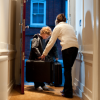The News
Not only do we often see the disaster actually happening but we are there, sometimes for days on end, working with rescue crews as they dig bodies out of rubble, examine wreckage of crashed aeroplanes or disentangle mangled cars, or with journalists as they talk to survivors of terrorist attacks, or grieving parents of missing or dead children. What isn’t captured by the film crew is often supplemented by witnesses’ camera footage taken on mobile phones.
The impact these disasters have on children is usually greater than on adults, as children haven’t yet developed the desensitization that adults have in order to protect themselves. After the events of 9/11 and the Boxing Day tsunami, counselling lines were set up for those who have been affected by what they had seen on television. The lines were very busy and many of the calls were from minors.
While it is important our children are aware of world events, what they know about needs to be age appropriate, and they shouldn’t have to witness more than their young minds can cope with. I think we can be lulled into a false sense of security by believing that what is shown on the early evening news must be suitable family viewing. Recently a boy of ten I was fostering was so upset by a massacre at a school in America, as reported on a children’s news programme, that he had nightmares, and kept asking me if it could happen at his school. I spent a long time reassuring him.
I think talking about the issues helps and we need to put the disasters into perspective for our children. Tsunamis, earthquakes and volcanic eruptions don’t happen every day; security is tight to prevent terrorist attack; travelling by plane remains one of the safest forms of travel etc. The world we live in can be a very sad and scary place for any child, even more so for a child who is already vulnerable.
Cathy x (www.cathyglass.co.uk)





